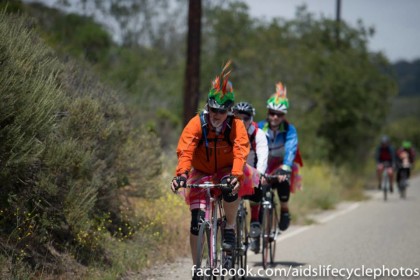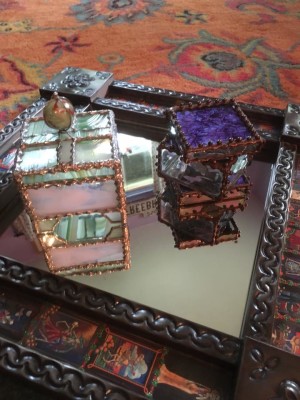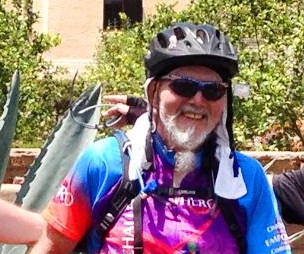![]() Q: Jim, welcome to A News Cafe.com. Thanks for taking time to talk with me about this special upcoming event, The AIDS LifeCycle ride. The purpose of this ride is to raise money for the life-saving services offered by San Francisco AIDS Foundation and the Los Angeles LGBT Center.
Q: Jim, welcome to A News Cafe.com. Thanks for taking time to talk with me about this special upcoming event, The AIDS LifeCycle ride. The purpose of this ride is to raise money for the life-saving services offered by San Francisco AIDS Foundation and the Los Angeles LGBT Center.
You’ve participated in five of these rides so far.

James Freemon, Cecina Hines and Ben Murray in the 2014 AIDS LifeCycle ride. AIDS LifeCycle Facebook photo.
First, can you tell a little about yourself, please?
I am happily married and have four children and four grandchildren. I am 70 years old and retired. I have been a endurance athlete since my return from Vietnam in 1966. I retired from the phone company then worked as a contract lineman and finished my formal working years as a maintenance man and fitness instructor.
Q: It’s a rare person who retires, and then becomes a 70-year-old spinning instructor. What kinds of reactions have you had from your students?
I am very successful as a spinning instructor. I have filled our class and have had to turn people away due to the lack of enough bikes. I recently started teaching spinning at Wellgate Sports Club, and classes are growing.
You are welcome to come to my class. I know you are working on your fitness program, and it would be an honor to have you in class.
Q: I have no doubt you are successful, because you are a legendary spinning teacher. I’ve taken just one spinning class, from my friend Monica at the YMCA, and it was a butt-kicker. Thank you for the invitation to your class. I promise to take you up on it. But enough about me.
The reason we’re talking today is because of the AIDS LifeCycle event, during which you’ll ride with thousands of other bicyclists for hundreds of miles. Tell us about it.
On June 5, 3,000 riders will leave the Cow Palace in San Francisco to ride 545 miles in seven days to Los Angeles. The purpose of the ride is to raise funds to help end AIDS, and to help those with AIDS/HIV, as well as their families. Each
participant must raise a minimum of $3,000 dollars to ride. Support staff “volunteers” must also raise a smaller amount to support the riders. You can visit AIDS LifeCycle at aidslifecycle.org to learn and see what AIDS LifeCycle is all about.
Q: Even a car ride from San Francisco to Los Angeles is a haul. I just cannot imagine riding a bike that distance. It just boggles my mind. Plus you’re almost 71, so you are totally breaking endurance stereotypes, but that seems to be something you do with ease. I mean that as a compliment.
So you’ve been an endurance athlete since you returned from Vietnam in 1966 – 50 years ago. First, what’s your definition of an endurance athlete, and how did you manifest it? Second, was being in Vietnam and becoming an endurance athlete related?
When we returned home from Vietnam we were not very well-received. I had some depression and anger problems. I went to get help, they just laughed at me. I lived a half of a block from a park, so I began walking around the perimeter of the park. Then I began to jog. There weren’t any running shoes at that time; only track shoes. I entered local runs in the Bay Area and found I had great endurance. I entered longer races, like around around Lake Tahoe. Those kind of races are considered endurance.
Running was a vehicle to help me deal with my mental problems. I would leave my home in Richmond, run to Tilden Park in Berkeley, then to the Oakland Hills, and then back to Richmond again. It would take most of an 8-hour day.
Q: Incredible. But as helpful as those runs were for you, something happened to end your running days, right?
Yes, I injured myself on the AIDS Lifecycle ride in 2005, which ended my days of running.
Q: That’s horrible, Jim. What happened?
Before I left for the ride I was having pain. At the time I was working at Redding Fitness Center, and while there I had collected more than $5,000 for the AIDS LifeCycle ride. I felt responsible to those who donated, so I went ahead and went on the ride. At first, I didn’t think it was a big thing. But by the fifth day things went really bad. I had drop foot, and I could barely walk. I collapsed that day and they took my bike away.
After that came a seven-hour surgery. I had something called spinal stenosis; that was part of the problem, and I don’t remember all the other technical terms. I also lost control of my bladder. I now have six rods in my back, an artificial hip, two cervical fusions in my neck and a new aortic valve in my neck.
My doc just hoped I’d walk again, but I had other plans. It took six months to recover. By then, running was out of the question, so I started riding.
Q: I’m so glad you did walk again, and went on to ride bikes. But I have to say, most people, if they’d been injured as badly as you were, would throw in the towel. They’d vow to never do that ride again. Everyone would understand.
Jim, why do you keep doing it? You’ve already sacrificed so much.
Once you ride shoulder to shoulder with people who are willing to ride for seven days and 545 miles; it’s life-changing. We sleep on the ground, use porta potties, endure extreme heat, bad roads, lots of crazy drivers and drink gallons of Gatorade. Then when we sit in camp and I hear their stories; I want to ride with these heroes.
There’s a saying, “All talk and no go makes Jack a dull boy.” These people are willing to suffer for their fellow man. I want to be a part of that.
Q: That’s a beautiful, humbling answer, Jim. I don’t even know how else to reply, except to say thank you.
Back to the ride, which is coming up next week, do you remember what initially inspired your involvement in your first AIDS LifeCycle ride?
My wife and I were in San Francisco eating at a restaurant in 2002 when I saw a brochure in the window about the ride. Back then the ride was 585 miles. Connie — my wife — said, “You could do that.”
I took the brochure home and signed up. At that time, it was just another challenge for me. It wasn’t until I started raising funds and participating in the ride when I realized the significance of what I was really doing. Then, I was working at Redding Fitness Center, and I’d mention about the upcoming AIDS LifeCycle ride, and that I was raising funds. Time after time older couples – mothers and fathers – would come into my maintenance office, shut the door and write me a check. For many of them, it was the first time in years they’d shared about a son, a daughter, a mother, or a dad who’d died of AIDS. They did not feel they could freely share about the death of someone they loved to AIDS, due to the stigma attached to HIV/AIDS.
Q: I know I bought some beautiful jewelry you’d made, as well as your incredible little glass boxes – also handmade by you – as part of your fundraiser for this event. What else have you done to raise money?

One of the ways James Freemon raised money for the AIDS LifeCycle ride was to make and sell jewelry and glass boxes.
I have sold bike parts at bike swaps, I’ve provided my services fixing bikes and selling bikes that I’ve built. I also go to those who’ve supported me in the past.
I am $250 short of my $3,000 goal. While doing this interview, with tears in my eyes, I am reminded, once again, why I ride. We have the power to make this world a better place. You can participate with a tax-deductible donation. You can write a check payable to Aids LifeCycle, or go to aidslifecycle.org, click on “find participant” and type in my name: James Freemon. It will take you to my home page, there you may donate.
James Freemon crosses the finish line at the AIDS LifeCycle ride in 2014.
Q: So, you’re almost to your goal amount, which we hope will be helped by this interview on A News Cafe.com. The fundraising part is one thing, but you are actually doing this ride, aren’t you? It sounds like a grueling ride.
Yes. The ride is not a piece of cake. We average about 83 miles a day. The second day is the longest day, with 108 miles from Santa Cruz to King City. We sleep in tents on the ground, and we use porta potties for a week. Aids LifeCycle provides great food, portable showers, and the very best in support. It truly takes a team to get us all to L.A. We cover our own expenses for plane tickets home, transportation to the airport, bike shipping and lodging in San Francisco before we leave. If you visit aidslifecycle.org you can see the route and see video of a day on the ride
Q: That’s pretty ambitious for someone of any age. What’s your biking experience, and how are you training for this?
I am 70 years old, and will turn 71 on July 4. I ride about 100 miles a week. I have ridden several club rides all over the state. The latest was the Sierra Century in Plymouth, California.
Q: What is it about riding a bike that you like?
Riding a bicycle not only keeps me fit, but it allows me to meditate and gather my mind. Riding seems to be the best exercise for my back. I want to keep moving, and share with as many people as I can the joy and benefits of riding.
Q: Do you know how many other north state people will be joining you on this ride?
I know of two riders from Redding. Cecina Hines will be riding with me. She is a cancer survivor, and she asked if I thought she could do the Aids LifeCycle ride. She bought a bike, and we trained and rode Aids LifeCycle in 2014. Cina ask if i would ride this year, which of course, I will. And off we will go.
Q: Jim, you’re an inspirational guy, and I sincerely wish you all the best. Tell us what we can do to help you?
At this moment your donation would help. Just go to my page on AIDS LifeCycle.org.
Q: Anything else you’d like us to know?
Thank you to all who have supported me with your hard earned dollars, and a big thank you to A News Cafe for your service to the Redding community.
Oh, you’re welcome, Jim. But trust me when I say you’re doing the really hard part, and for that, I appreciate you. Thank you!





